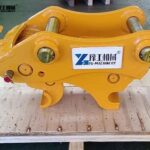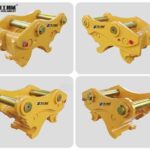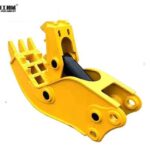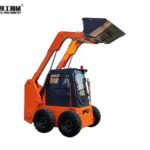Quick hitch coupler, also known as a quick coupler or hydraulic quick hitch, is a mechanical or hydraulic device that enables operators to connect and disconnect attachments, such as buckets, blades, forks, or hammers, to heavy machinery like excavators, loaders, or tractors without manual intervention. Traditional attachment changes require operators to leave the cab, manually align pins, and secure bolts—a time-consuming and potentially hazardous process. Quick hitch couplers eliminate these steps, allowing attachments to be swapped in seconds, directly from the operator’s seat.
Applications Across Industries
- Construction
Excavators: Swap buckets, hammers, and rippers for digging, demolition, or trenching.
Skid Steers: Attach pallet forks, brooms, or cold planers for site cleanup and maintenance.
Loaders: Use grapples or snow blades for material handling or winter service. - Agriculture
Tractors: Connect mowers, plows, or bale spears for seasonal farming tasks.
Telehandlers: Lift hay bales or feed with fork attachments.
Harvesters: Adapt to crop-specific heads for efficient harvesting. - Forestry
Log Loaders: Secure grapples or processors for timber harvesting.
Skidders: Attach winches or trailers for dragging logs. - Waste Management
Loaders: Use clamshell buckets or compaction plates for landfill operations.
Excavators: Mount shear attachments for recycling scrap metal.
How Does An Excavator Quick Hitch Work in Practice?
The operational sequence demonstrates the efficiency leap:
- Positioning: The operator maneuvers the machine so the open quick hitch coupler jaws are roughly aligned over the attachment’s top and bottom pins.
- Engage Top Hook: Lowering the dipper arm engages the coupler’s top hook over the attachment’s top pin.
- Capture Bottom Pin(s): The operator activates the coupler’s control (hydraulic lever or mechanical handle). The latching mechanism swings, slides, or rotates to securely close around the attachment’s bottom pin(s).
- Locking: The locking mechanism engages automatically or is manually secured, ensuring the latch cannot open unintentionally. The safety lock is engaged.
- Connect Hydraulics/Electronics: The operator connects the attachment’s hydraulic hoses and/or electrical connectors to the machine’s quick couplers.
- Detachment: The process is reversed: disconnect hydraulics/electronics, disengage the safety lock, activate the coupler control to release the latch, lift slightly to disengage the top hook, and drive away.
Benefits of Using a Quick Hitch Coupler
The adoption of a excavator quick coupler offers several significant advantages for businesses and operators in construction, demolition, landscaping, and mining industries.
- Time Savings
Excavator quick hitch drastically reduces the time it takes to switch between attachments. What used to take 10 to 30 minutes can now be done in under several minutes, leading to higher productivity. - Increased Safety
Operators can stay inside the cab while changing attachments, minimizing exposure to hazardous environments. Hydraulic and automatic quick couplers come with locking indicators that ensure proper attachment. - Versatility
Machines equipped with a quick hitch coupler can handle a wider range of tasks using various attachments. This flexibility allows a single piece of machinery to serve multiple functions. - Reduced Labor Costs
Since no additional labor is needed to assist with attachment changes, companies can allocate resources more efficiently and reduce overhead expenses. - Enhanced Equipment Lifespan
Proper and secure attachment reduces wear and tear on the machine and its implements, thereby extending the equipment’s operational life.






